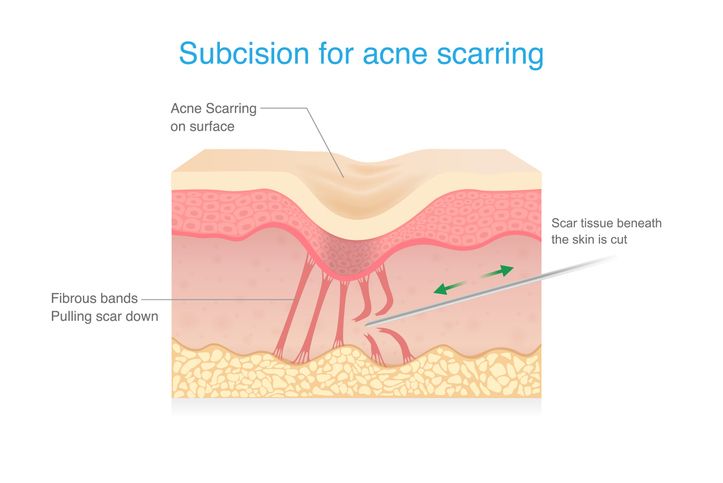Posted October 26, 2025 in subcision

Subcision (short for subcutaneous incisionless surgery) is a minor in-office procedure used to treat depressed or rolling acne scars caused by fibrous bands pulling the skin downward.
During treatment, a fine needle or cannula is inserted beneath the scar to release these fibrotic strands. Once released, the skin rises to a more even level, and the body’s natural healing process stimulates new collagen production, gradually improving texture and firmness over time.
How Subcision Works
- Topical numbing is applied to ensure comfort.
- A small needle or blunt cannula is inserted beneath the scar.
- The provider moves the instrument in a gentle fanning motion to break the fibrotic attachments tethering the skin.
- The released area begins to fill with newly formed collagen as it heals, improving skin smoothness and elasticity.
Most treatments take under 45 minutes and require little downtime.
Ideal Candidates for Subcision
You may be a good candidate for subcision if you have:
- Rolling scars that move minimally when the skin is stretched.
- Boxcar scars with sharply defined edges.
- Tethered or anchored scars caused by fibrotic bands.
Subcision is not ideal for raised or hypertrophic scars, which typically require steroid injections or laser treatment.
Benefits of Subcision
✨ Targets the root cause – Releases scar tissue that pulls the skin down.
✨ Stimulates collagen – Encourages natural healing and long-term improvement.
✨ Quick recovery – Minimal downtime; most patients return to normal activity in 1–2 days.
✨ Visible, lasting results – Scars become progressively shallower with each session.
✨ Customizable treatment – Can be performed alone or combined with microneedling, laser resurfacing, or fillers.
Subcision offers an excellent foundation for overall scar improvement, often forming the first step in a multi-modal acne scar treatment plan.
Risks and Side Effects
Subcision is considered very safe when performed by trained professionals, but as with any procedure, there are potential side effects:
- Temporary bruising or swelling at the injection site
- Mild tenderness or soreness for a few days
- Rare hematoma formation (localized bruise)
- Slight post-inflammatory hyperpigmentation (PIH) in darker skin tones
- Very rare infection (minimized with sterile technique and post-care)
At Mountcastle Medical Spa, every subcision procedure is performed under sterile conditions with advanced techniques designed to minimize discomfort and complications.
Results: What to Expect
Most patients notice gradual improvement in scar depth over 4–8 weeks as new collagen forms.
For best results, a series of 2–4 treatments spaced 4–6 weeks apart is typically recommended.
Combining subcision with microneedling with PRF enhances collagen remodeling and promotes faster healing.
Over time, the skin becomes noticeably smoother, firmer, and more refined.
Effectiveness Backed by Research
Clinical studies have consistently shown subcision to be an effective treatment for rolling and boxcar acne scars.
A 2019 analysis published in Dermatologic Surgery reported significant patient satisfaction and measurable improvement in scar depth when subcision was performed by experienced providers.
By physically releasing the scar’s fibrous anchor points, subcision treats the mechanical cause of indentation, something creams and surface-only treatments can’t reach.
Alternatives and Complementary Treatments
While subcision is one of the most effective options for tethered scars, many patients benefit from a combination approach that addresses both depth and surface texture.
Complementary and alternative treatments include:
- Microneedling or RF Microneedling (Morpheus8) – for collagen remodeling and texture improvement.
- Laser Resurfacing – reduces pigment and refines skin tone.
- Dermal Fillers – lift released scars for a smoother contour.
- Chemical Peels – improve pigment and mild surface irregularities.
Your provider will design a customized treatment plan based on your scar type, skin tone, and comfort level.
Recovery and Aftercare
After subcision, you may experience mild swelling or bruising that resolves within a few days. Applying cool compresses and following your post-care instructions will ensure optimal healing.
Avoid direct sun exposure, exfoliation, and aggressive skincare for one week.
Over the next several months, as collagen production increases, you’ll notice continued improvement in scar texture and overall skin quality.
Who Should Perform Subcision?
Subcision is a technique-sensitive procedure that requires a thorough understanding of facial anatomy and scar behavior.
For safety and best results, it should only be performed by licensed medical professionals trained in advanced aesthetic procedures.
At Mountcastle Medical Spa & Laser Center, our team — including Meredith West, PA-C, and Dr. Madeline David, NP, under the direction of Dr. Timothy Mountcastle, Double Board-Certified Plastic Surgeon — has extensive experience treating all types of acne scarring with customized, layered approaches.
Schedule Your Consultation
If acne scars are affecting your confidence, subcision can help reveal smoother, more radiant skin.
Our team in Ashburn, VA serves women and men throughout Northern Virginia who want proven, medical-grade solutions for scar revision.
Call or Text: 571-266-1776
Email: info@mountcastlemedspa.com
44095 Pipeline Plaza, Suite 270, Ashburn, VA 20147
